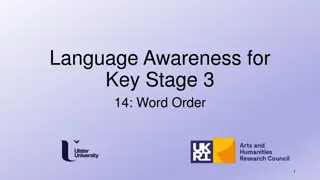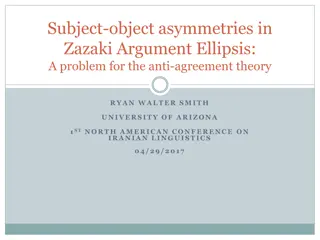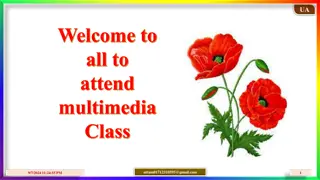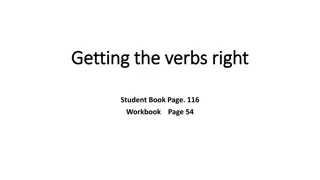Mastering Subject-Verb Agreement for Clear Communication
Understanding subject-verb agreement is essential for clear and effective communication. Ensure that your subjects and verbs align in number, even when interrupted by phrases. Learn to identify and handle disruptive word groups, and grasp the rules for using "and" and "or" correctly. This guide helps you navigate common pitfalls and master the art of subject-verb agreement.
Download Presentation

Please find below an Image/Link to download the presentation.
The content on the website is provided AS IS for your information and personal use only. It may not be sold, licensed, or shared on other websites without obtaining consent from the author. Download presentation by click this link. If you encounter any issues during the download, it is possible that the publisher has removed the file from their server.
E N D
Presentation Transcript
Subject-Verb Agreement Adapted from Real Good Grammar, Too by Mamie Webb Hixon
Be sure subjects and verbs agree. Subjects and verbs agree when they are both singular or both plural. A singular subject needs a singular verb. A plural subject needs a plural verb.
Watch out! Words between the subject and the verb often confuse people: Colonel Mendoza, along with his assistants, is running headquarters very efficiently. It might appear that the singular verb is should be the plural verb are because the plural noun assistants is directly adjacent to the verb. However, along with his assistants is a prepositional phrase between the subject Colonel Mendoza and the verb is. Ignore the prepositional phrase. The basic sentence is, Colonel Mendoza is running headquarters very efficiently.
Deal with disruptive word groups. Find the subject to determine whether each sentence requires is or are. The people who listen to that genre of music are few. Subject: the people (plural) Verb: are (plural) The team captain, as well as his players, looks anxious. Subject: the team captain (singular) Verb: looks (singular) The book, especially all the chapters in the first section, is boring. Subject: the book (singular) Verb: is (singular)
Look for the word and. When several subjects are connected by and, use a plural verb. item 1 item 2 The pen and pencil are in the drawer. While it is true that there is only one pen and one pencil in the drawer, what matters is that there are ultimately two items in the drawer. Use the plural verb are, not the singular verb is. thing 1 thing 2 thing 3 The soft sand, crystal-clear water, and warm sun attract many tourists. Because the three subjects are connected by and, use the plural verb attract, not the singular attracts.
Look for the words or and nor. When nouns or pronouns are connected by or or nor, the verb agrees with the closest subject. The host or her guests are expected to leave the tip. The guests is the closer subject; since guests is plural, use the plural verb are. The guests or the host is expected to leave the tip. The host is the closer subject; since host is singular, use the singular verb is.
Pay attention to indefinite pronouns. These words are always singular: words ending in -body, -one, or -thing (e.g. anybody, someone, nothing) either, neither, another each, every, one
Pay attention to indefinite pronouns. Everybody loves cupcakes. Everybody is tricky because it seems plural, but it considers only one person at a time: each person loves cupcakes individually. The people in everybody are not acting as a group but as a collection of single subjects. Neither of the teams has ever won a championship game. The word teams can make the plural have seem like the right choice, but you need the singular has because you are considering neither one of the teams. Neither indicates that you are considering one at a time, not both at once, so the singular verb is appropriate.
Pay attention to indefinite pronouns. These words are always plural: Both, many, several Here is an example of a plural indefinite pronoun. Several students were at the game. Plural indefinite pronouns are typically followed by plural nouns like students, so agreement with plural indefinite pronouns is not usually problematic. Here, we re talking about several students considered as a group, so the plural were is appropriate.
Pay attention to indefinite pronouns. Some indefinite pronouns can be either singular or plural: none, some, all, most, many, any Here are some examples of indefinite pronouns that can be either singular or plural. Some of the letters were at the post office. Words like some depend on their prepositional phrases. Here, the word letters is plural, so the plural were is appropriate. Some of the mail was at the post office. Mail is a mass noun we re talking about the whole pile of mail, not individual letters. Mail is singular, so we use the singular was.
Be careful with measurements. This rule applies to time, distance, weight, and money. When referring to individual units, use a plural verb: Dollars are America s national currency. Miles are part of the imperial system of measurement. When referring to an amount, use a singular verb: One hundred dollars is not a lot of money. Twenty miles is a long distance to run daily. Think of twenty miles or one hundred dollars as a single unit.
Be careful with here and there. Here s means here is. There s means there is. We might say, There s a million things I need to do before my trip. Here s some examples of my work. We really mean, There are a million things I need to do before my trip. Here are some examples of my work. Note: Neither there nor here can be the subject of a sentence. When these words open a sentence, look for the subject following the verb. Things and examples are plural subjects, so the plural are is appropriate.
Pay attention to collective nouns. Collective nouns are nouns that include or imply more than one person but act as a unified group: a group of tourists a team of mules a class of students a family of people from Pace a jury of your peers a band of robbers a herd of cattle a crew of pirates
Pay attention to collective nouns. If the members of a collective noun are working together or are being referred to as a whole, the word takes a singular verb: The jury has reached a verdict. The crew is making its plans. The members of the jury are acting as a single unit, so jury takes a singular verb. Likewise, the members of the crew are acting as a single unit, so crew takes a singular verb.
Pay attention to collective nouns. If the group members are not acting together or you are referring to individual effort within the group, the word takes a plural verb: The jury have disagreed throughout the trial. The crew are preparing the ship. Here, the members of the jury are acting separately, and the members of the crew are performing separate actions within the group.
Watch out for gerunds. A gerund is an ing verb acting as a noun. Finding qualified candidates seems difficult. Ignore the object of the gerund, qualified candidates, and make your verb agree with the singular gerund finding. Dwelling on past disappointments is unhealthy. The plural word disappointments might make are seem correct, but the subject of the sentence is actually the gerund dwelling, so the singular verb is is correct.
Know the inclusion/exclusion rule. Exclusion the subject is not part of the group, so use a singular verb: Jason is the only one of the students who smokes. The key to this rule is the word group the only one. The word only tells us that Jason smokes but no one else in the group does. Jason is singular, so the singular verb smokes is correct. Inclusion the subject is part of the group, so use a plural verb: Henry is one of the students who smoke. Here, the subject is one of rather than the only one. The words one of indicate that Henry is included in a group of students who all smoke. Students is plural, so the plural verb smoke is correct.
Be careful with number of Subjects preceded by a number of or a percentage of always require a plural verb: A number of UWF s students are returning to college after having been in the workforce for years. Subjects preceded by the number of or the percentage of always require a singular verb: The percentage of female college students has exceeded the percentage of male students since the late 1970 s. Think of a number of as general, and therefore plural you could be referring to any number. The number of, on the other hand, is specific only one number so use a singular verb.
Make verbs agree with borrowed nouns. Some English words borrowed from other languages can be confusing because their plural forms do not end in s. The media are not invited. One endangered medium is print news. We are used to referring to media as singular, like a collective noun, but it is actually the plural of medium. Using the plural verb will sound odd, but since media is in fact plural, do so in formal writing. No new data are available. Each datum shows one person s survey response. Data is even harder to recognize as plural than is media because its singular form datum is not a word we use frequently, or indeed at all. A datum is a single point of information, and data are the collected points of information.
You will never be an alumni! Alumni is another word English borrowed from Latin. It has two gendered plural forms and two gendered singular forms. Alumnus is singular and masculine: Alumna is singular and feminine: He is an alumnus of UWF. She is an alumna of UWF. Alumni is plural and masculine: Alumnae is plural and feminine: The three men are alumni The three women are alumnae of UWF. of UWF. For a mixed group, we traditionally default to the masculine: The graduates are alumni of UWF.























